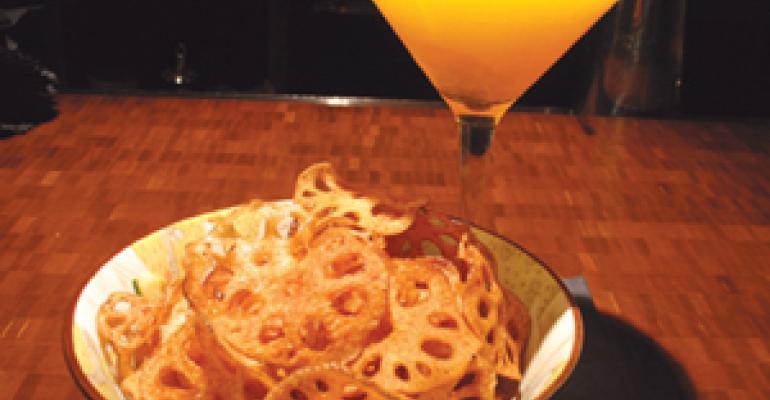When Christopher Lee took over as executive chef of Gilt, a fine-dining restaurant at the Palace Hotel in New York City that was hemorrhaging money, his first task was to revamp the menu.
Then he looked at the bar.
“We were spending $1,400 a month on giving away free peanuts,” he recalls.
And peanuts tend to fill you up, he adds—not a desirable quality for a freebie.
So instead he’s serving lavosh, a crispy Middle Eastern flat bread, cut into funky shapes and sprinkled with salt.
“To me a bar snack should be light and salty, so it gets customers’ palates stimulated so they can actually order off the bar menu or drink something,” Lee says.
His target cost for the lavosh is $800 a month.
Restaurant operators are finding that creative bar snacks play many roles, from building goodwill and giving good first impressions to encouraging more drinking.
“We want to keep with the feel of the rest of the restaurant,” says Missy Robbins, chef of Spiaggia in Chicago. “From the time people walk in to the time they leave, we want to reflect the same image.”
That includes starting the restaurant experience with nibbles of the unexpected, such as savory biscotti spiced with sea salt, almonds, black pepper, rosemary and Parmigiano-Reggiano cheese.
“I think customers feel taken care of really well from the moment they sit down and have their first cocktail,” Robbins says. “It’s sort of an extra first step we take.”
She says the costs of bar snacks and little after-dinner treats are factored into the budget.
At H20 in Smithtown, N.Y., executive chef Scott Szekretar uses things he would otherwise throw away. During the winter and spring, he saves potato peelings, soaks them for 24 hours, rinses them thoroughly and then deep-fries them. He tosses them in Cajun seasoning and serves them at the bar.
Summers in Smithtown, which is on Long Island, are so humid that the fried skins tend to wilt, so instead he serves focaccia breadsticks topped with things like sesame, poppy seeds, granulated onions, or sea salt with black pepper.
“We make our own focaccia here anyway,” Szekretar says, which makes the cost negligible.
Kevin Jennings, who heads up Urban Food Group in Raleigh, N.C., which owns the restaurants Frazier’s, Porter’s City Tavern, Vivace and South, explains that a slightly souped-up bar snack says to customers: “In every aspect of the restaurant we can do a great job.”
So they serve house-made potato chips, which are sliced lengthwise for grander presentation and dusted with garlic salt, salt and black pepper. He puts them in “these cool wooden baskets” and sets them on the bar.
“Sometimes we’ll toss them with scallions, or with blue cheese when they’re hot,” he says, although he admits that that extra step, which requires that they come straight out of the kitchen, “has proven to be more difficult.”
At Amalia, a restaurant in the Dream Hotel in New York City, pastry chef John Miele is in charge of a snack that customers have found addictive enough to spend more time at the bar. He pops corn in olive oil, sprays it with more olive oil and then dusts it with cocoa, a Moroccan-influenced spice mix and ground sea salt.
Then he tosses some of the popcorn in a caramel made of sugar, butter and—to keep it crunchy—a little baking soda.
“It shows that we’re taking a little bit of an extra step to try to please the customer and give them something a little different,” he says.
The customers have responded by going through about 40 gallons of the popped kernels every week.
At Mai House, an upscale Vietnamese restaurant in New York City that is owned by Myriad Restaurant Group, the bar snack is fried lotus-root chips.
“It’s a component we have throughout the menu,” sous chef Sean Cotese says of lotus root, which has Swiss-cheese-like holes that give the slices visual appeal.
Cotese peels them, slices them on a mandolin and fries them at a low temperature—250 to 275 degrees Fahrenheit—to help reduce shrinkage.
He then adds salt and a spice mix that includes smoked paprika, star anise, turmeric, black pepper, salt and sugar.
“It’s not a ground-breaking item, but it exemplifies what we’re trying to do here,” he says.
Some restaurants use their bar customers as informal focus groups.
“We do a few different things,” says Myles Romanow, owner of Wildthyme Restaurant and Bar in Southampton, N.Y., adding that what’s served at the bar depends on who’s sitting there.
“We usually have either an astute bartender or manager on the floor who can act in a pit boss kind of capacity,” he says. They assess the crowd and determine what they might like to eat.
If 40-somethings are watching a sporting event on the plasma screen TV at the bar, drinking and looking like they want to keep drinking, the kitchen sends out fried calamari. If ladies are chatting at the bar, the kitchen might send out tuna rolls or vegetarian spring rolls.
Romanow’s wife owns a takeout shop, Thyme and Again.
“So we always have cookies, linzertortes, pecan squares, lemon squares,” he says. “So if we have an older couple that’s enjoying an after-dinner drink at the bar, we can send those out.”
During Monday Night Football, three-bean chili and cornbread is served at the bar.
Ladies Night, on the other hand, is “an excuse for our guys to get creative in the kitchen,” Romanow says. So they’ll play around with the trim from tuna belly or test out items for catering and special events.
And of course little snacks encourage people to stay at the bar, and that gives the restaurant good energy.
“People come in, realize what a great time they have and come again and again,” he says.




